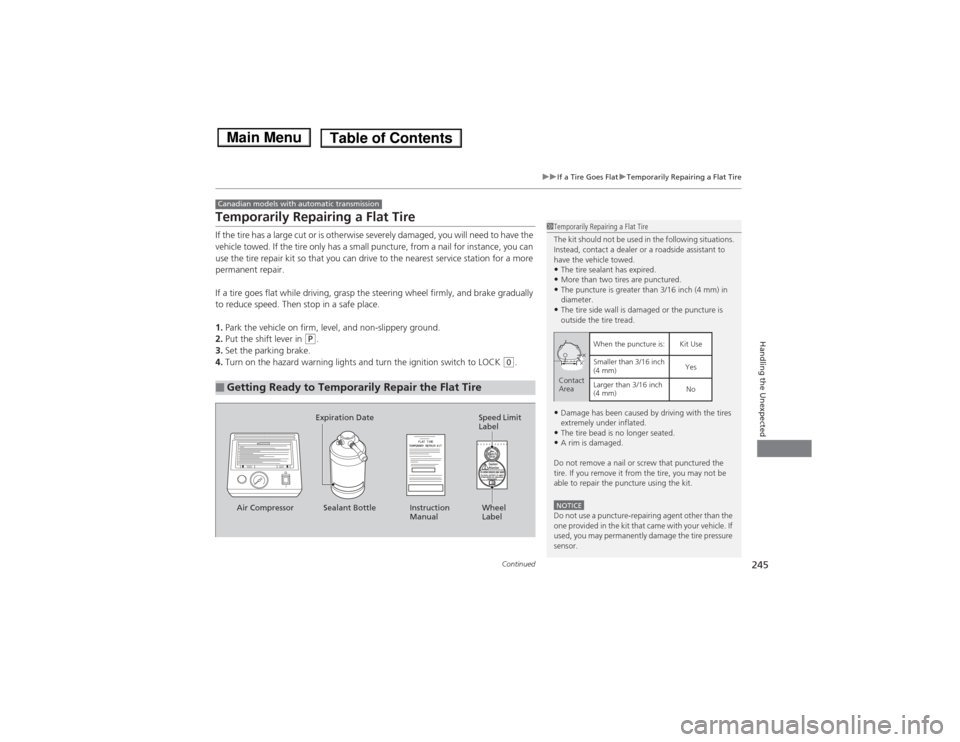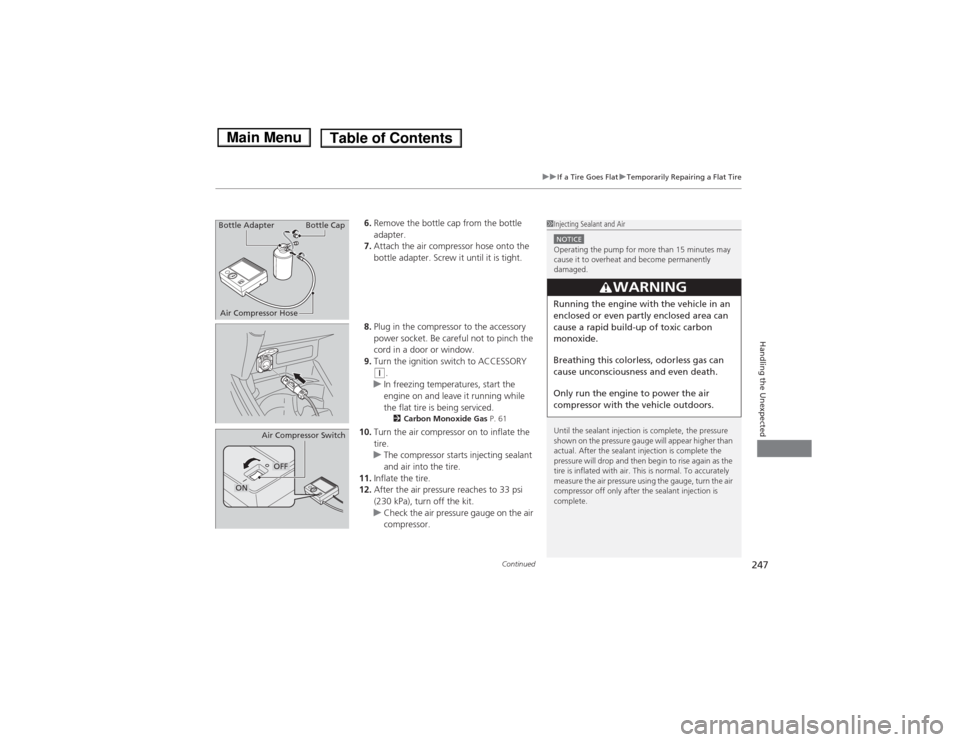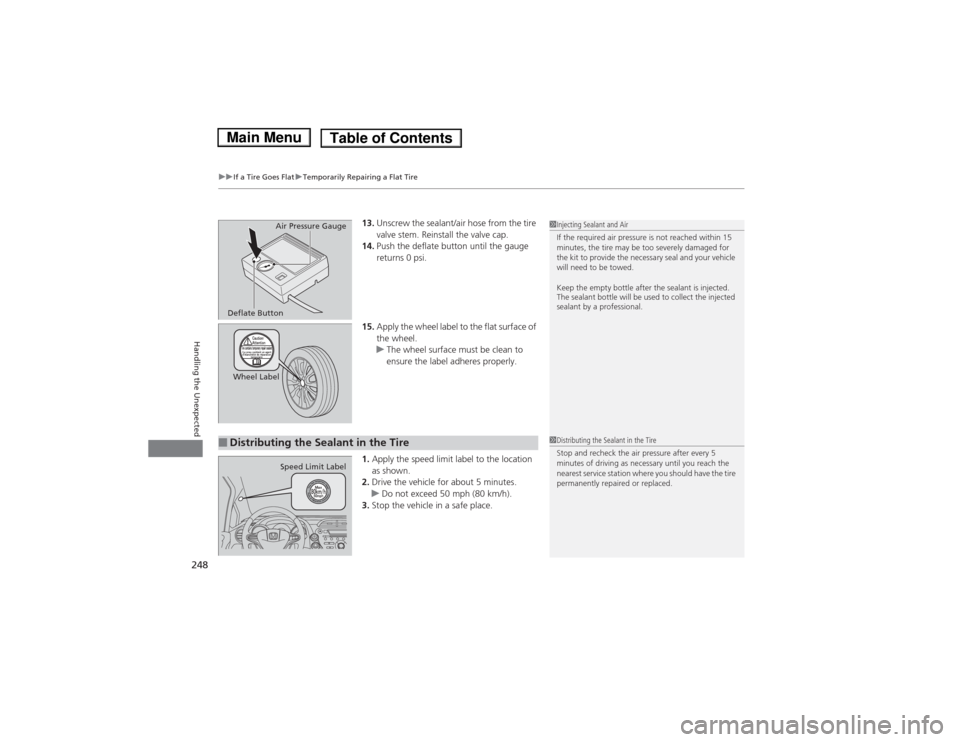Page 246 of 289

245
uuIf a Tire Goes FlatuTemporarily Repairing a Flat Tire
Continued
Handling the Unexpected
Temporarily Repairing a Flat TireIf the tire has a large cut or is otherwise severely damaged, you will need to have the
vehicle towed. If the tire only has a small puncture, from a nail for instance, you can
use the tire repair kit so that you can drive to the nearest service station for a more
permanent repair.
If a tire goes flat while driving, grasp the steering wheel firmly, and brake gradually
to reduce speed. Then stop in a safe place.
1.Park the vehicle on firm, level, and non-slippery ground.
2.Put the shift lever in
(P.
3.Set the parking brake.
4.Turn on the hazard warning lights and turn the ignition switch to LOCK
(0.
■Getting Ready to Temporarily Repair the Flat TireCanadian models with automatic transmission
1Temporarily Repairing a Flat Tire
The kit should not be used in the following situations.
Instead, contact a dealer or a roadside assistant to
have the vehicle towed.•The tire sealant has expired.•More than two tires are punctured.•The puncture is greater than 3/16 inch (4 mm) in
diameter.•The tire side wall is damaged or the puncture is
outside the tire tread.•Damage has been caused by driving with the tires
extremely under inflated.•The tire bead is no longer seated.•A rim is damaged.
Do not remove a nail or screw that punctured the
tire. If you remove it from the tire, you may not be
able to repair the puncture using the kit.NOTICEDo not use a puncture-repairing agent other than the
one provided in the kit that came with your vehicle. If
used, you may permanently damage the tire pressure
sensor.
When the puncture is:
Smaller than 3/16 inch
(4 mm)
Larger than 3/16 inch
(4 mm) Kit Use
Yes
No Contact
Area
Instruction
Manual Air Compressor Wheel
Label Sealant Bottle Expiration Date
Speed Limit
Label
Page 248 of 289

Continued
247
uuIf a Tire Goes FlatuTemporarily Repairing a Flat Tire
Handling the Unexpected
6.Remove the bottle cap from the bottle
adapter.
7.Attach the air compressor hose onto the
bottle adapter. Screw it until it is tight.
8.Plug in the compressor to the accessory
power socket. Be careful not to pinch the
cord in a door or window.
9.Turn the ignition switch to ACCESSORY (q.
uIn freezing temperatures, start the
engine on and leave it running while
the flat tire is being serviced.2Carbon Monoxide Gas P. 61
10.Turn the air compressor on to inflate the
tire.
uThe compressor starts injecting sealant
and air into the tire.
11.Inflate the tire.
12.After the air pressure reaches to 33 psi
(230 kPa), turn off the kit.
uCheck the air pressure gauge on the air
compressor.
1Injecting Sealant and AirNOTICEOperating the pump for more than 15 minutes may
cause it to overheat and become permanently
damaged.
Until the sealant injection is complete, the pressure
shown on the pressure gauge will appear higher than
actual. After the sealant injection is complete the
pressure will drop and then begin to rise again as the
tire is inflated with air. This is normal. To accurately
measure the air pressure using the gauge, turn the air
compressor off only after the sealant injection is
complete.
3
WARNING
Running the engine with the vehicle in an
enclosed or even partly enclosed area can
cause a rapid build-up of toxic carbon
monoxide.
Breathing this colorless, odorless gas can
cause unconsciousness and even death.
Only run the engine to power the air
compressor with the vehicle outdoors.
Bottle Adapter
Air Compressor HoseBottle Cap
Air Compressor SwitchOFF
ON
Page 249 of 289

uuIf a Tire Goes FlatuTemporarily Repairing a Flat Tire
248Handling the Unexpected
13.Unscrew the sealant/air hose from the tire
valve stem. Reinstall the valve cap.
14.Push the deflate button until the gauge
returns 0 psi.
15.Apply the wheel label to the flat surface of
the wheel.
uThe wheel surface must be clean to
ensure the label adheres properly.
1.Apply the speed limit label to the location
as shown.
2.Drive the vehicle for about 5 minutes.
uDo not exceed 50 mph (80 km/h).
3.Stop the vehicle in a safe place.
Air Pressure Gauge
Deflate Button
Wheel Label
■Distributing the Sealant in the Tire
1Injecting Sealant and Air
If the required air pressure is not reached within 15
minutes, the tire may be too severely damaged for
the kit to provide the necessary seal and your vehicle
will need to be towed.
Keep the empty bottle after the sealant is injected.
The sealant bottle will be used to collect the injected
sealant by a professional.1Distributing the Sealant in the Tire
Stop and recheck the air pressure after every 5
minutes of driving as necessary until you reach the
nearest service station where you should have the tire
permanently repaired or replaced.
Speed Limit Label
Page 250 of 289
249
uuIf a Tire Goes FlatuTemporarily Repairing a Flat Tire
Handling the Unexpected
4.Recheck the air pressure using the gauge
on the air compressor.
uDo not turn the air compressor on to
check the pressure.
If the air pressure is:
uLess than 19 psi (130 kPa), do not add air
or continue driving. The leak is too
severe. Call for help and have your
vehicle towed.
2Emergency Towing P. 264u33 psi (230 kPa) or more, continue
driving for another 5 minutes or until you
reach the nearest service station. Do not
exceed 50 mph (80 km/h).
uGreater than 19 psi (130 kPa), but less
than 33 psi (230 kPa), add air using the
pump until the tire pressure reaches 33
psi (230 kPa), then drive carefully for 5
more minutes or until you reach the
nearest service station. Do not exceed 50
mph (80 km/h).
5.Repackage and properly stow the kit.
Page 253 of 289
252
uuJump Startingu
Handling the Unexpected
Once your vehicle’s engine has started, remove the jumper cables in the following
order.
1.Disconnect the jumper cable from your vehicle’s ground.
2.Disconnect the other end of the jumper cable from the assisting vehicle’s battery
- terminal.
3.Disconnect the jumper cable from your vehicle’s battery + terminal.
4.Disconnect the other end of the jumper cable from the assisting vehicle’s battery
+ terminal.
Have your vehicle inspected by a nearby service station or a dealer.■What to Do After the Engine Starts
Page 265 of 289
264Handling the Unexpected
Emergency TowingCall a professional towing service if you need to tow your vehicle.■Flat bed equipment
The operator loads your vehicle on the back of a truck.
This is the best way to transport your vehicle.■Wheel lift equipment
The tow truck uses two pivoting arms that go under the front tires and lift them off
the ground. The rear tires remain on the ground. This is an acceptable way to
tow your vehicle.
1Emergency TowingNOTICETrying to lift or tow your vehicle by the bumpers will
cause serious damage. The bumpers are not designed
to support the vehicle’s weight.NOTICEImproper towing such as towing behind a
motorhome or other motor vehicle can damage the
transmission.
Never tow your vehicle with just a rope or chain.
It is very dangerous, since ropes or chains may shift
from side to side or break.
Page 268 of 289
267
Information
This chapter includes your vehicle’s specifications, locations of identification numbers, and other
information required by regulation.
Specifications.................................... 268
Identification Numbers
Vehicle Identification Number (VIN) .. 270Engine Number and Transmission
Number...................................... 270Devices that Emit Radio Waves....... 271
Reporting Safety Defects................. 272Emissions Testing
Testing of Readiness Codes.............. 273
Warranty Coverages........................ 275
Authorized Manuals......................... 277
Customer Service Information......... 278
Page 278 of 289
277Information
Authorized Manuals■Service Express
For electronic copies of service publications, you can purchase a subscription to
Service Express. Visit www.techinfo.honda.com for pricing and options.■For U.S. Owners:
Manuals be purchased from Helm Incorporated. You can order a manual by phone
at (800) 782-4356 (credit card orders only), or online at www.helminc.com.
1Authorized Manuals
For Canadian Owners:
Please contact a dealer to order any manuals that you
may require.